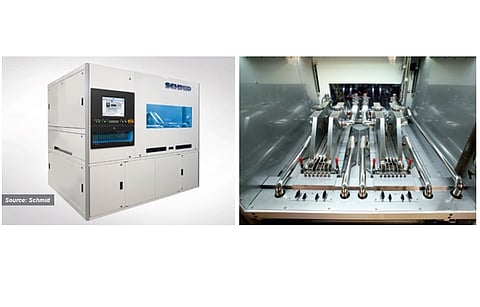

As mentioned in our previous articles on TOPCon solar technology published recently, nearly every know deposition technology in PV is promoted for this silicon solar cell application – and PEALD and APCVD are among those.
Leadmicro has developed a hybrid technology called PEALD, which the company abbreviates as Plasma Enhanced Atomic Layer Deposition. It is a hybrid platform combining advantages of ALD and plasma assisted deposition methods. In fact, Leadmicro was the first to introduce the technology. The Chinese company is mainly promoting its ZuRong (ZR) series industrial batch furnace, which is specially tailored for TOPCon related applications. The competitive advantages of ZR5000X2 models, according to the spec sheet, are its ability to support deposition of various oxide films and ALD nanolaminates with dedicated in-situ doping. The precise control of the process enables achieving desired energy bandgap, band alignment and resistances, thereby effectively passivating the surface and providing good carrier selectivity. The automation integrated into the machine platform supports accomplishing all the necessary steps of rear passivation in TOPCon, i.e., generating tunneling oxide and in-situ doped polysilicon in one go. The product supports different throughput levels depending on the wafer size; when processing M6 wafers, ZR series has a rated throughput of 4,200 wafers per hour, while the processing ability drops considerably to 2,800 level when processing larger silicon substrates (M10 and G12). The deposited films have high uniformity with a deviation of 3%. The tool has a rated uptime of 98% and keeps the mechanical yield losses less than 0.05%.
The company's ZR5000X3 system is a dual side depositing system. In PERC applications, the tool is equipped to apply a stack of aluminum oxide and silicon nitride on the rear, while also depositing silicon nitride on the front. The system is also capable of single side processing if desired, in case of which the throughput simply doubles. According to Leadmicro, the tool is also compatible with depositing TOPCon structures.
APCVD
Schmid from Germany is the only company to have an APCVD based solution for passivated contacts. One benefit of using an APCVD system is that it allows the use of multiple injector heads in series within a single system. The system delivers a throughput of up to 4,000 wafers per hour depending on the thickness of the layer to be applied. Schmid says its product can also support in-situ doping; however, the tunneling oxide would need to be applied externally.
Two notable advantages of the APCVD process are: a) it is a simple atmospheric process, and b) that it does not cause wraparound. According to Schmid, its APCVD solution eliminates one processing step from a total of 8 compared to using PECVD or LPCVD. The technology, though, has somehow escaped the attention of TOPCon makers. One reason, according to Schmid, is its reluctance to supply free demo tools. (see LPCVD for TOPCon Cells)
This brief article is taken from our recent TaiyangNews report on TOPCon Solar Technology, which is available for free download here.
An overview of the report was presented during TaiyangNews High Efficiency Solar Technologies Conference, where Day 3 of the conference focussed mainly on TOPCon. To learn more about the conference and view the presentations click here.
As today the workhorse of the solar industry are still PERC cells, TaiyangNews will organize a virtual conference on Pushing PERC Cells to Its Limits on March 22, 2022 – and Leadmicro will speak at the event as well. To register for free, please click here
